How to independently mount plumbing in the house
Arrangement of water supply in a private house is one of the main conditions for comfortable living outside the city. As a rule, engineering networks and the internal system are laid during the construction phase of a house, however, sometimes it becomes necessary to connect water supply to a building that has been in operation for a long time. To help in this matter, we will consider in detail how to make plumbing in the house.
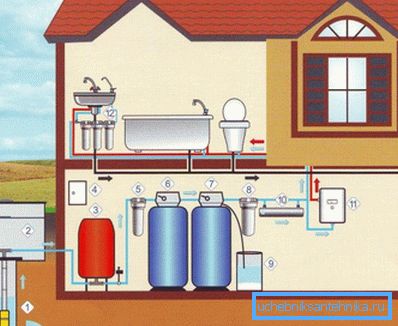
General information
Water supply scheme
Conditionally home plumbing can be divided into several main nodes:
- Source of water supply.
- An outdoor system that provides water from a water source to a home.
- Internal system - is a wiring from the inlet pipe to the plumbing fixtures.
It follows that the work is carried out in stages. Moreover, the sequence may be different.

Types of water supply
Plumbing in a country house can be divided into two types:
| Autonomous | In this case, a well or a well can be used as a source of water supply. To ensure the supply of water to the house under a certain pressure will need special equipment. In addition, special filters may be required to purify water from various contaminants. |
| Central | This option is the cheapest and easiest to implement, since in this case it is only necessary to connect the external system to the central highway, without the need to use additional equipment. |
Below we consider the features of the device of each of these systems.

Autonomous water supply
Equipment
For the arrangement of autonomous water supply, only the source itself will be needed, i.e. well or well, and equipment. Suppose there is already a source at the site. Now you need to purchase equipment for plumbing in a country house.
It should be noted that the choice of equipment depends on the type of water source:
| For artesian well | In this case, water can be extracted only with the help of a special submersible pump that is immersed in the well. Its installation is a rather complicated procedure, therefore, in order not to spoil expensive equipment, it is better to entrust this work to specialists. |
| For wells and shallow wells | For such sources of water you will need a conventional pumping station, which consists of the following elements:
|
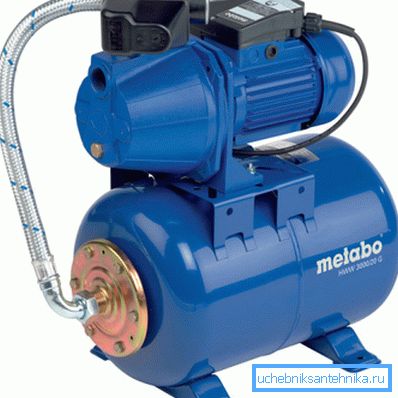
As mentioned above, an autonomous water supply system requires the installation of filter equipment. There are quite a few options for how to clean tap water at home, but they are selected individually, in accordance with the results of chemical and bacteriological analysis of water. The latter can be done in SES or private laboratories that provide similar services.
Note! Drinking water from a well or a well without first performing water analysis and cleaning it is strictly prohibited, as this can lead to serious diseases.
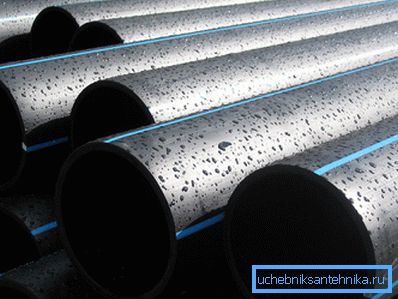
Pipe selection
After all the necessary equipment has been purchased, you should choose pipes for external plumbing.
I must say that there are quite a few options, however, the following types of pipes are most often used for these purposes:
- Steel - It was not so long ago that pipes of this type were used, however, recently they have lost their popularity. This is due to the fact that plastic analogues appeared on the market, which are cheaper and at the same time are superior to steel products for their performance.
- Low pressure polyethylene pipes - are an excellent option for external plumbing, as they have sufficient strength and durability. In addition, due to the plasticity they easily bend, which may be necessary if the trenches have minor turns.
- Polypropylene - this type of pipe is one of the most common, since it is an analogue of HDPE pipes, but at the same time their price is lower.
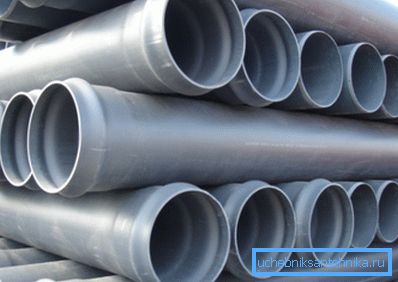
- Polyvinyl chloride - Unlike PND this material is more rigid, besides well tolerates exposure to sunlight. Therefore, such pipes can be used for open areas of external plumbing.
In general, all types of these plastic pipes are excellent for the indicated purposes. As for steel products, it makes sense to use them only if there are enough pipes left in stock after performing any other work.
Pipeline laying from a well or well
Having prepared everything you need, you can proceed to the device external water supply.
Instructions for the implementation of this work is as follows:
- The installation of a water supply system begins with the excavation work - digging trenches from a well or well to a house. To do this, you first need to perform their markup.
Dig trenches to a depth below the level of soil freezing. In different areas, the soil freezes to a different depth, however, on average in our country, this figure is 1.4 meters, so trenches are dug to a depth of 1.6 meters.
- Then the bottom of the trench is leveled and sprinkled with a layer of sand that needs to be compacted.
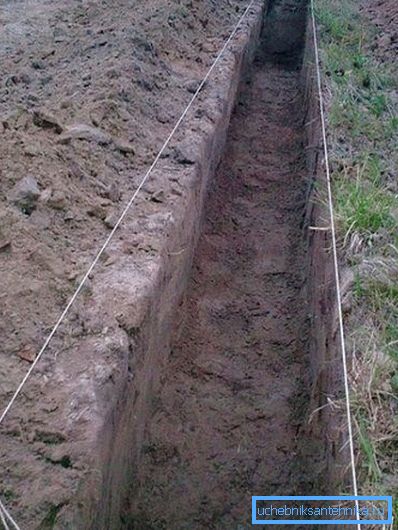
- Further, a pipe with a diameter of at least 32 millimeters is laid at the bottom of the trench. Moreover, the pipeline should lie at a slight inclination to the source in order to prevent stagnation of water in the system.
The connection of pipes to each other can be done in a different way, depending on the material from which they are made. On our portal you can find a detailed description of this process for different types of pipes.
- After that, a hole is made in the foundation of the house. You can drill it with a diamond crown. A heat-insulating sleeve must be inserted into the hole so that the water does not freeze in extreme cold at the passage.
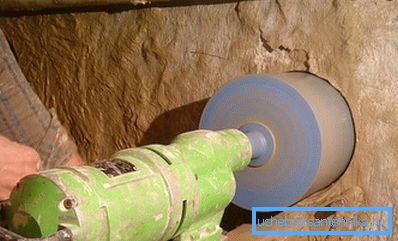
- A water valve is installed through the sleeve into the house and a ball valve is installed at the side of the house.
- Then a hole is made in the well ring.
- Next, the pipe is put into the well water intake.
- As a rule, equipment is installed and connected to the pipe in the basement or at another entry point of the pipeline. Connection diagram is included with the equipment.
- After installation and connection of all elements of the system, it is necessary to check its performance.
- If the faults have not been identified, the trenches should be buried. To do this, first sand is poured, and then the ground.
Approximately the same is done and the wiring of the pipeline and from the well, the only one, above the well itself, at a level below the ground freezing depth, a caisson is installed, as shown in the diagram.
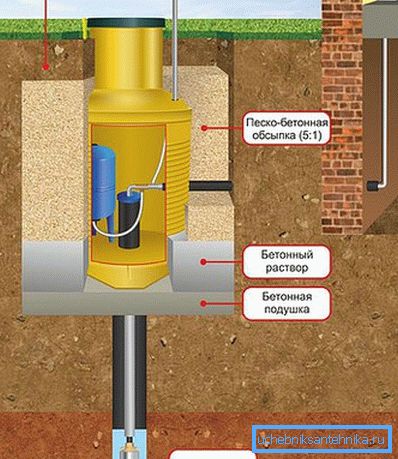
Features of the central water supply
Now consider how to get water into the house from the water supply. This option of water supply is the most optimal in those cases when the central highway passes near the site.
Before you begin work, you must obtain permission to connect to the highway from the water supply organization, as well as from local authorities. And only after that you can proceed to the device system.

Project
It is necessary to begin the device of a water supply system from performance of the project on which it is necessary to represent:
- Plot plan;
- The location of the central highway;
- The location of all fittings and external sources of water consumption, if you plan to install them.
- The point of entry of plumbing into the house.
The presence of the project will allow to calculate the distance from the house to the water supply system and, accordingly, to calculate the amount of materials. In addition, it will serve as a kind of work plan, therefore it will allow to avoid mistakes.
Note! When drafting a project, it is necessary to take into account that, according to the existing standards, the distance between the water supply system and the gas pipeline should be at least 1 m horizontally and at least 0.2 m vertically.
Installation Features
The laying of the pipeline to connect to the central highway in general does not differ from the device of autonomous water supply. Similarly, trenches are dug from the house to the central highway. The peculiarity is the insertion of the external system into the central highway.
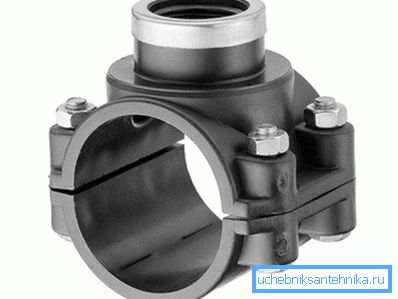
If there is an opportunity to shut off the water in the line, then it will not be difficult to perform a tie-in - you just need to make a hole in the pipe and weld a drain to it, or use a fitting with a hose clamp. This procedure is much more complicated if it is not possible to turn off the water.
In this case, the work is carried out in the following order:
- First of all, the section of the pipe on which the inset will be performed is carefully cleaned.
- Then a saddle is put on the highway.
- Next to the tap is mounted ball valve.
- After that, a special drilling device is attached to the ball valve.
- Next, through the hole in the gland fixtures and open ball valve, a cutter is inserted and a hole is drilled in the pipe.
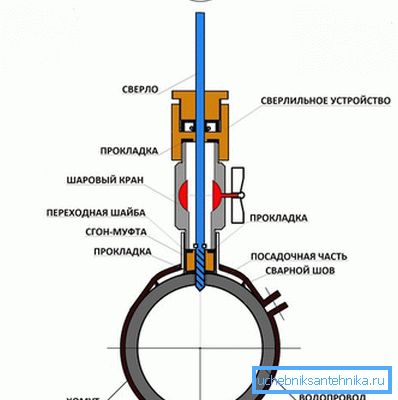
- After completion of the work, the cutter is pulled out and the ball valve is immediately shut off.
- Then the device for drilling is dismantled.
- A well is installed at the place where the water supply is inserted into the main. For these purposes, you can use concrete rings. In the absence of construction equipment, the well can be laid out of brick.
- After installation of all elements of the outdoor system, open the water supply and make sure that the water supply system is tight.
- At the end of the work, it is necessary to bury the trenches according to the scheme described above.
It should be noted that the sidebar is a rather complicated procedure, so it is better not to try to do it yourself, but to immediately entrust the specialists.
Device internal plumbing
After the outdoor system is completed, you can proceed to the installation of internal plumbing. It is necessary to begin work with drawing up the project scheme.
At this stage it is necessary to determine the following points:
- The number of sources of water consumption.
- The location of the plumbing fixtures.
- Wiring installation method.
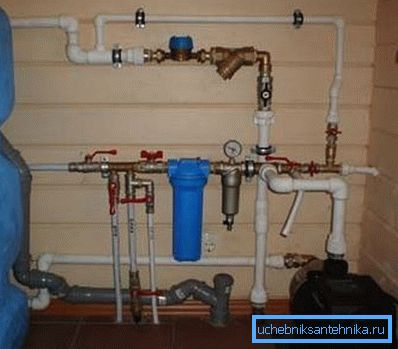
The system can be wired in two ways:
- Serial connectivity is great for small homes that use multiple sources of water consumption.
- Collector - in this case, the water supply is connected to the collector, from which the parallel wiring to all plumbing fixtures is carried out.
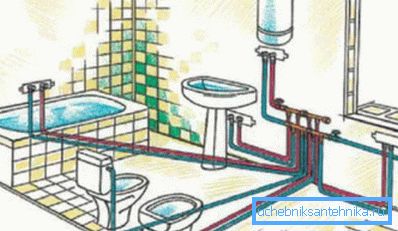
Note! Regardless of the type of wiring, shut-off valves must be installed before each device. This will allow water to be blocked when repairing or replacing plumbing.
After drawing up the scheme, you only need to assemble the plumbing as a constructor. This process, as in the case of the outdoor system, depends on the type of pipes. For example, polypropylene pipes, which are the most common recently, are welded to the fittings with a special soldering iron. Metal-plastic plumbing can be assembled using compression fittings without the use of special equipment.
Tip! If over time the pressure in the water supply has decreased, you need to clean the pipes. For this, there are special formulations that can be purchased in household chemicals stores. On the packaging of such tools is usually described in detail how to clean the water pipes at home.
Here, perhaps, the main points that you need to know for the proper organization of plumbing in a private house.
Conclusion
It is relatively easy to equip water supply in a private house. The main thing is to comply with a certain sequence and basic building codes. Of course, special attention should be paid to the connections of all the elements so that the system is sealed.
You can read more information on this topic from the video in this article.